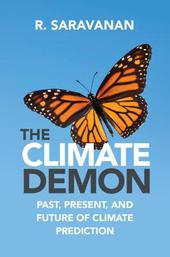
|
The Climate Demon: Past, Present, and Future of Climate Prediction
Paperback / softback
Main Details
| Title |
The Climate Demon: Past, Present, and Future of Climate Prediction
|
| Authors and Contributors |
By (author) R. Saravanan
|
| Physical Properties |
| Format:Paperback / softback | | Pages:350 | | Dimensions(mm): Height 229,Width 155 |
|
| Category/Genre | History of science
Global warming
Social impact of environmental issues |
|---|
| ISBN/Barcode |
9781009018043
|
| Classifications | Dewey:551.63 |
|---|
| Audience | | Tertiary Education (US: College) | | Professional & Vocational | |
|---|
| Illustrations |
Worked examples or Exercises
|
|
Publishing Details |
| Publisher |
Cambridge University Press
|
| Imprint |
Cambridge University Press
|
| Publication Date |
21 October 2021 |
| Publication Country |
United Kingdom
|
Description
Climate predictions - and the computer models behind them - play a key role in shaping public opinion and our response to the climate crisis. Some people interpret these predictions as 'prophecies of doom' and some others dismiss them as mere speculation, but the vast majority are only vaguely aware of the science behind them. This book gives a balanced view of the strengths and limitations of climate modeling. It covers historical developments, current challenges, and future trends in the field. The accessible discussion of climate modeling only requires a basic knowledge of science. Uncertainties in climate predictions and their implications for assessing climate risk are analyzed, as are the computational challenges faced by future models. The book concludes by highlighting the dangers of climate 'doomism', while also making clear the value of predictive models, and the severe and very real risks posed by anthropogenic climate change.
Author Biography
R. Saravanan is Head of the Department of Atmospheric Sciences at Texas A&M University. He is a climate scientist with a background in physics and fluid dynamics and has been a lead researcher using computer models of the climate for over thirty years. He built an open-source simplified climate model from scratch, and has worked on complex models run on the world's most powerful supercomputers. He has worked with scientists at multiple climate modeling centers: the Geophysical Fluid Dynamics Laboratory (GFDL) in Princeton; the UK Universities Global Atmospheric Modelling Programme (UGAMP) in Cambridge; and the National Center for Atmospheric Research (NCAR) in Boulder, Colorado. Saravanan has served on national and international committees on climate science, including the National Research Council (NRC) Committee on the Assessment of Intraseasonal to Interannual Climate Prediction and Predictability, and the Science Steering Committee of the Prediction and Research Moored Array in the Atlantic (PIRATA). He recently helped create the TED-Ed animated short, 'Is the weather actually becoming more extreme?'.
Reviews'If you wish to correctly interpret climate modeling results, read The Climate Demon. Saravanan's brilliant and humorous book helps both scientists and the general public objectively understand strengths and limitations of climate predictions.' Samuel Shen, San Diego State University 'A wide-ranging guided tour of the modern science of climate prediction, told by a leading expert without jargon or mathematics, and illuminated by history, philosophy, technology and even literature.' Richard C.J. Somerville, Scripps Institution of Oceanography, University of California, San Diego 'Output from climate models completely underpins our policies on cutting emissions and making society more resilient to future climate - issues that will be affecting everyone on the planet in years to come. I thoroughly recommend this book if you want to understand the science behind these all-important [climate] models.' Tim Palmer, University of Oxford 'R. Saravanan is probably the most knowledgeable person in the world to write this book. This is a book that is accessible to the average college graduate and even many with less formal education. The pace of the reading is smooth, with many metaphors and analogies taken from a wide variety of sources ... all whimsical but hitting his points perfectly. Readers will enjoy these features. This is a first rate, well-researched summary and analysis of how predictions in climate science work hand-in-hand with high-tech empirical data and detailed climate simulation models along with their enabler: the modern supercomputer.' Gerald R. North, Texas A&M University
|